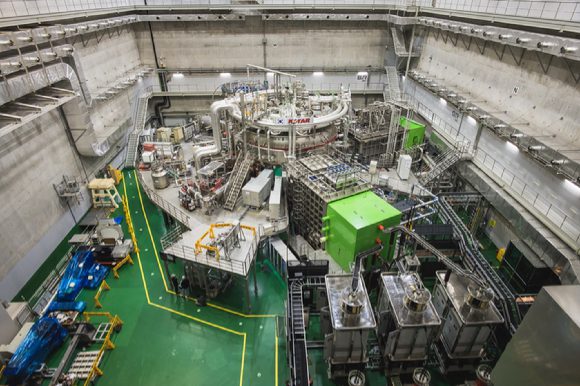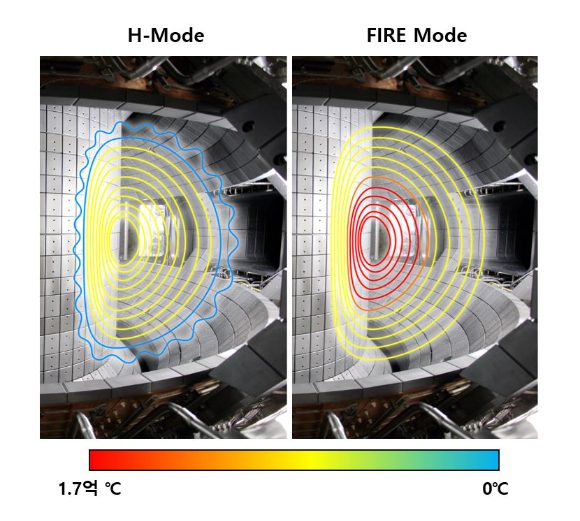A research team consisting of Professor Na Yong-soo (corresponding author) from the Department of Nuclear Engineering, Seoul National University, Han Hyun-sun, PhD, Korea Fusion Energy Research Institute, and Park Sang-jin, Seoul National University Dept. Master’s and Doctoral Course of Energy Systems Engineering (above first author) was published in the international scientific journal Nature on 8 A new plasma operating mode called ‘Ion Regulated Enhancement’ has been announced.
The research team hopes that this new operation mode will overcome the shortcomings of the existing operation mode and can be used as an alternative scenario for use in future commercial fusion reactors.

To achieve the goal of producing large-capacity energy through nuclear fusion, it is necessary to secure a technology that can permanently confine the very high temperature and high-density plasma in a nuclear fusion reactor.
The most representative plasma operation mode is ‘H-Mode (High Confinement Mode)’, also known as high-performance plasma operation mode, which is considered the basic operation mode for operating a commercial fusion reactor.
However, in the H-mode, when the pressure at the edge of the plasma exceeds a critical value, an ‘edge localized mode (ELM)’ can occur that bursts like a balloon, damaging the inner wall. Fusion reactor. Accordingly, fusion researchers are studying how to control the ELM and searching for a more stable plasma operation mode.
Through analysis of operational data and simulation verification of KSTAR, high-speed ions (high-energy particles) generated during plasma heating stabilize the turbulence within the plasma and rapidly raise the plasma temperature. It is called ‘Fire Mode’. , a new driving mode.

The FIRE mode is created by concentrating the heating center at a relatively low plasma density. In this new mode, the researchers found that the drawbacks of H-mode such as interface instability (ELM) and other serious instability phenomena did not occur and the impurities did not accumulate in the plasma.
The research team explained that this mode also has the advantage of being easy to control while showing similar or higher performance to H-mode, opening up new possibilities for securing plasma operation technology in future commercial fusion reactors. However, he added that since it currently operates at low concentrations, research needs to continue to reach a state where the concentration of the plasma can continue to be increased while maintaining high temperatures.
In 2021, the KSTAR research team succeeded in operating an ultra-high temperature plasma with an ion temperature of 100 million degrees for 30 seconds, a world record at the time. The research team said, “This research result is significant in recognizing the fundamentality of the long-term operation of ultra-high-temperature plasma achieved at KSTAR over the past few years by the general academic community.” Based on physics. The understanding of high-speed ions is expected to contribute to the development of nuclear fusion demonstration reactor operation technology.
Professor Na Yong-soo said, “The fire mode is a case that shows that Korean fusion research can be conducted in a real way unlike the existing one. KSTAR) was built with great precision, and this was possible through close cooperation between domestic. Foreign universities and research institutes.
Dr. Han Hyun-sun said, “This research result was made possible by a new approach, focusing on the temperature aspect and the heating performance of KSTAR in the center of the plasma on three conditions to realize nuclear fusion: density, temperature, and confinement time of the plasma.” More about Fire Mode and High-Speed Ion Through research, KSTAR’s 100 million degree ultra-high temperature plasma will further improve operational performance and lifetime.”
/ Correspondent Choi Sang-guk(skchoi@inews24.com)

Prone to fits of apathy. Unable to type with boxing gloves on. Internet advocate. Avid travel enthusiast. Entrepreneur. Music expert.


![[지금은 과학] A new way to operate a nuclear fusion [지금은 과학] A new way to operate a nuclear fusion reactor has been discovered](https://swordstoday.ie/wp-content/uploads/2022/09/1662604572_지금은-과학-A-new-way-to-operate-a-nuclear-fusion.jpg)

